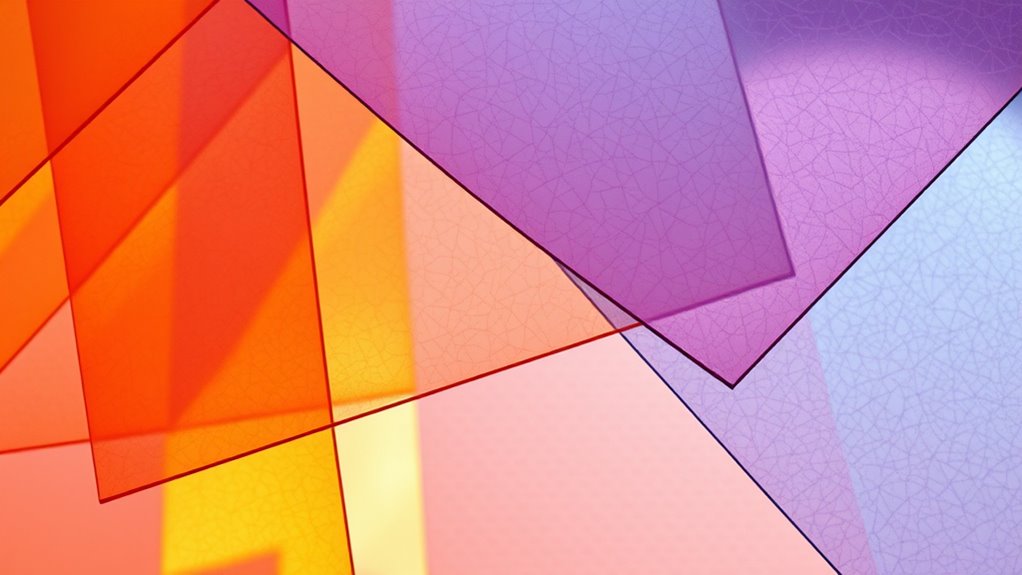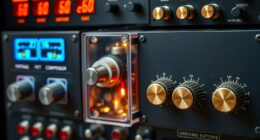Using modal interchange, you can add emotional depth to your music by borrowing chords from parallel modes like Lydian or Phrygian. This technique shifts the tonal color, evoking feelings such as wonder, longing, or tension. You can enhance this effect further by applying expressive techniques like vibrato or subtle phrasing. Combining these approaches enables you to craft richer emotional landscapes—continue exploring, and you’ll discover how to make these colors truly resonate.
Key Takeaways
- Borrow chords from parallel modes to evoke specific emotions like longing or wonder.
- Use chord extensions (9th, 11th, 13th) from borrowed chords to add tonal richness and emotional depth.
- Employ expressive techniques such as vibrato, glissando, and dynamic shading to emphasize harmonic shifts.
- Select modes (Lydian, Phrygian) strategically to create desired moods, enhancing emotional color.
- Combine modal interchange with subtle expressive touches to craft nuanced, emotionally compelling musical landscapes.

Music often evokes specific emotions, and one of the most effective tools for achieving this is modal interchange. When you incorporate modal interchange into your playing or composition, you tap into a rich palette of tonal colors that can dramatically shift the mood of a piece. One way to deepen this emotional impact is by using chord extensions and expressive techniques. Chord extensions—such as adding ninths, elevenths, and thirteenths—bring new layers of color and complexity, allowing you to craft sounds that feel more vivid, tense, or lush. These extensions are particularly powerful when you borrow chords from parallel modes during modal interchange, giving your progressions a fresh, unexpected character. For example, inserting a major seventh or ninth chord from a related mode can evoke feelings of longing or wonder, while more dissonant extensions can create tension or surprise.
Modal interchange with chord extensions enriches emotional depth and adds surprising tonal colors to your music.
Expressive techniques also play a vital role in emphasizing the emotional qualities of modal interchange. Techniques like vibrato, dynamic shading, and subtle phrasing allow you to highlight the emotional shifts created by modal borrowing. When you gently swell or soften a phrase, you guide the listener’s emotional response, making the tonal change more impactful. You can also use glissando or portamento to slide smoothly between chords borrowed from different modes, emphasizing the fluid nature of modal interchange and its ability to evoke a sense of journey or transformation. These expressive touches turn simple harmonic shifts into powerful emotional statements.
You don’t have to overcomplicate your approach, though. The key is to understand the emotional qualities associated with different modes and borrow chords that align with those feelings. For instance, borrowing from the Lydian mode can add a dreamy, optimistic quality, while borrowing from the Phrygian mode might introduce a darker, more introspective mood. By combining chord extensions with expressive techniques, you can further enhance these emotional effects. Play a borrowed chord softly and with a gentle bend, or emphasize a chord’s dissonance with a sharp attack to heighten tension. These small but deliberate choices make your music more emotionally compelling.
Ultimately, mastering modal interchange isn’t just about knowing which chords to borrow; it’s about how you bring them to life. Using chord extensions and expressive techniques, you can craft nuanced emotional landscapes that resonate deeply with your audience. When you skillfully blend these elements, you create music that not only shifts tonally but also touches the listener’s core feelings—making your compositions more memorable, meaningful, and emotionally rich.
Frequently Asked Questions
How Can Modal Interchange Enhance Songwriting Dynamics?
You can enhance songwriting dynamics through modal interchange by using chords substitution to add unexpected twists. This technique introduces new tonal colors, creating emotional depth that keeps listeners engaged. When you swap chords from parallel modes, it shifts the mood and intensifies feelings, making your song more expressive. Incorporating modal interchange allows you to craft more compelling harmonies, giving your music a richer, more nuanced emotional landscape.
Are There Genres That Benefit Most From Modal Interchange?
You’ll find that genres like jazz, pop, and folk benefit most from modal interchange. It allows you to create genre blending and adds emotional contrast, making your music more expressive. By shifting between modes, you can evoke different moods and keep your listeners engaged. Incorporating modal interchange helps you craft dynamic, emotionally rich compositions that resonate deeply, enhancing the overall impact of your songwriting.
How Do Musicians Identify Suitable Modes for Interchange?
You can identify suitable modes for interchange by listening carefully to how they add tonal ambiguity, like blending day and night in a single moment. Start with scale borrowing from related keys, experimenting with modes that share common tones. Trust your ear and analyze chord functions—if a mode creates the emotional color you want, it’s a perfect match. Practice improvising and recording to discover which modes resonate best in your music.
Can Modal Interchange Create Tension or Resolution Effectively?
Yes, modal interchange can create emotional tension or resolution effectively. When you switch to a borrowed mode, it introduces unexpected tonal colors that evoke emotional tension, making the music more engaging. Then, by returning to the original mode, you achieve tonal resolution, providing a satisfying sense of closure. This interplay keeps your listeners emotionally invested, as the tension and resolution work together to enhance the overall expressive power of your composition.
What Are Common Pitfalls When Applying Modal Interchange?
You should watch out for dissonant clashes that can make your harmony sound jarring, and avoid overuse pitfalls that can weaken your musical impact. Relying too heavily on modal interchange can create confusion or a lack of direction if not balanced properly. To keep your progressions engaging, use modal interchange thoughtfully, and always listen carefully for unintended dissonance or overuse that could detract from your emotional message.
Conclusion
Don’t worry if modal interchange feels complex at first—you’ll find it becomes intuitive with practice. By exploring different modes, you add emotional depth and color to your music, making your compositions truly stand out. Even if you think it’s too technical, remember that experimenting with modal shifts is simply a creative tool. Embrace the process, and you’ll discover how easily you can evoke powerful emotions and create mesmerizing soundscapes. Keep experimenting—you’re capable of mastering this technique.










